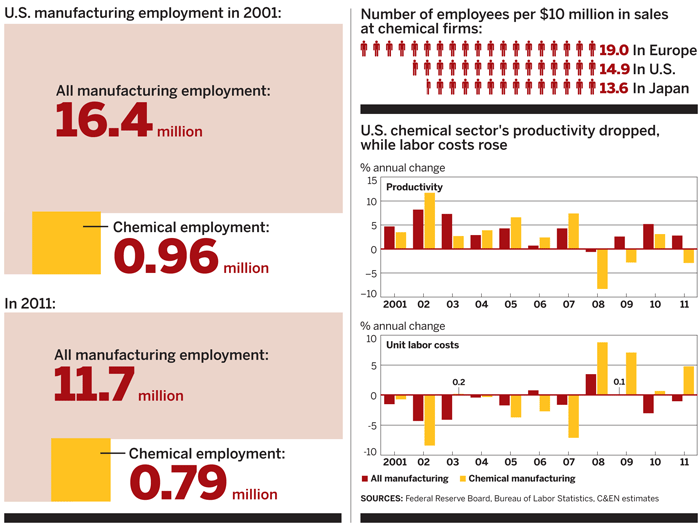Advertisement
Grab your lab coat. Let's get started
Welcome!
Welcome!
Create an account below to get 6 C&EN articles per month, receive newsletters and more - all free.
It seems this is your first time logging in online. Please enter the following information to continue.
As an ACS member you automatically get access to this site. All we need is few more details to create your reading experience.
Not you? Sign in with a different account.
Not you? Sign in with a different account.
ERROR 1
ERROR 1
ERROR 2
ERROR 2
ERROR 2
ERROR 2
ERROR 2
Password and Confirm password must match.
If you have an ACS member number, please enter it here so we can link this account to your membership. (optional)
ERROR 2
ACS values your privacy. By submitting your information, you are gaining access to C&EN and subscribing to our weekly newsletter. We use the information you provide to make your reading experience better, and we will never sell your data to third party members.
Business
Industry Slashes Thousands Of Jobs
Employment shrank significantly in Europe and the U.S. but held steady in Japan
by Assistant Managing Editor Michael McCoy, Senior Correspondent Marc S. Reisch, Senior Editor Alexander H. Tullo (all three in C&EN’s Northeast News Bureau), and Senior Correspondent Jean-François Tremblay (Hong Kong). Senior Editor Melody Voith (Washington, D.C.) collected data and coordinated the work.
July 5, 2010
| A version of this story appeared in
Volume 88, Issue 27
The chemical jobs picture in 2009 was startlingly different from that in 2008. Although the recession was well under way by the end of 2008, C&EN found that industry employment that year actually increased in Europe and Japan and decreased only slightly in the U.S. But by the end of 2008, most chemical firms had announced that layoffs were coming, and thousands of chemists lost their jobs over the next 12 months.
COVER STORY
Industry Slashes Thousands Of Jobs
In the U.S., the companies followed by C&EN laid off 28,000 employees, or more than 10% of their combined workforce in 2009. In the chemical industry as a whole, 5.2% fewer people were employed at the end of 2009 than at the end of 2008, according to the U.S. Department of Labor. The shrinkage was less than that in overall U.S. manufacturing, which lost a staggering 11.4% of its workforce.
All U.S. chemical firms tracked by C&EN laid off workers in 2009 except for H.B. Fuller and Stepan, where employment held steady. Between the acquisition of Rohm and Haas and several rounds of layoffs, Dow Chemical ended 2009 with 1,100 more employees than it started with. At the end of 2008, however, Rohm and Haas reported that it had 15,500 workers, meaning that thousands of former employees of the two firms are now looking for work.
As firms idled plants, production workers lost jobs at higher rates than those in the general chemical workforce. Production jobs declined by 6.8% compared with 2008, and layoffs occurred in every sector of the U.S. chemical enterprise, including pharmaceuticals, which had seen a decade of steady growth. Those left behind worked more hours and were more productive compared with 2008, but except for pharmaceutical workers, most did not enjoy significant pay raises.
Cost cutting in the pharmaceutical industry meant massive layoffs for medicinal chemists, starting in January when Pfizer announced 800 job cuts in R&D. By the end of the year, the big drugmaker had completed its acquisition of Wyeth and announced the elimination of an astounding 19,500 jobs. Merck & Co. said it would lay off 16,000 employees after its purchase of Schering-Plough. Johnson & Johnson, AstraZeneca, GlaxoSmithKline, and Eli Lilly & Co. also gave thousands of workers their walking papers during 2009.
The newly laid-off chemists faced a labor market in which long-term unemployment had become the rule rather than the exception. In 2009, according to the Bureau of Labor Statistics, the number of all workers unemployed for more than 27 weeks increased from 2.7 million in January to 6.1 million in December.
The employment picture was also bleak in Europe, where the 18 companies surveyed by C&EN shed nearly 20,000 jobs. Large layoffs occurred at BASF, AkzoNobel, Clariant, and Linde. Bucking the trend, Merck KGaA and Syngenta added workers.
In Japan, most chemical firms held on to their workers in 2009. Shin-Etsu Chemical, the only firm that significantly cut jobs, trimmed its payroll by 2,300 employees. The total number of jobs at Japanese firms surveyed by C&EN was up, due mostly to the acquisition of Mitsubishi Rayon by Mitsubishi Chemical Holdings.
Although chemical company executives finished the year vowing that earnings and the economy would rebound in 2010, none admitted to any plans to increase staffing. Instead, most said they would work hard to hold on to the fiscal discipline instilled in 2009 and harness the improved productivity of their remaining workforce to increase profit margins over the next few years.





Join the conversation
Contact the reporter
Submit a Letter to the Editor for publication
Engage with us on Twitter